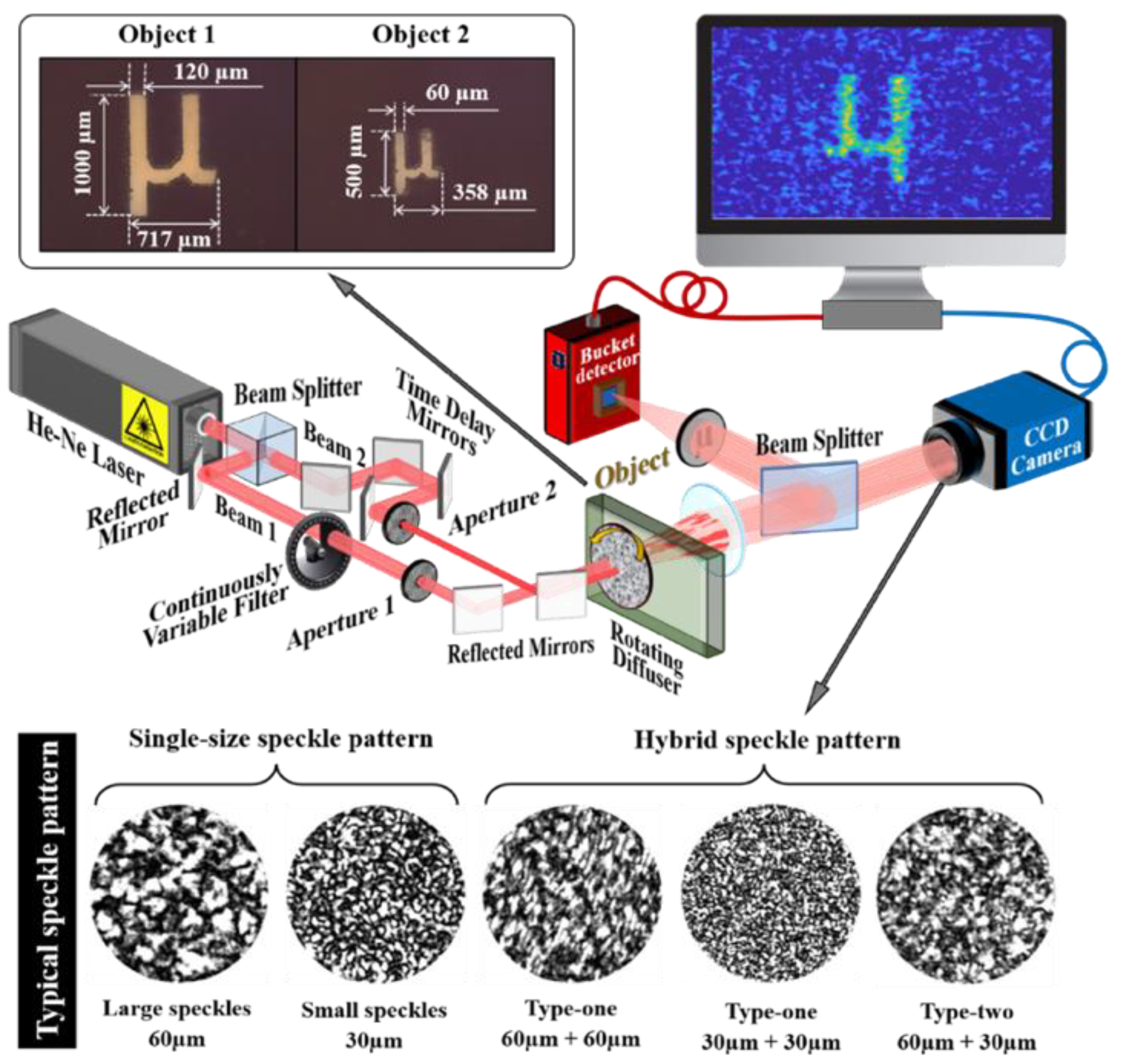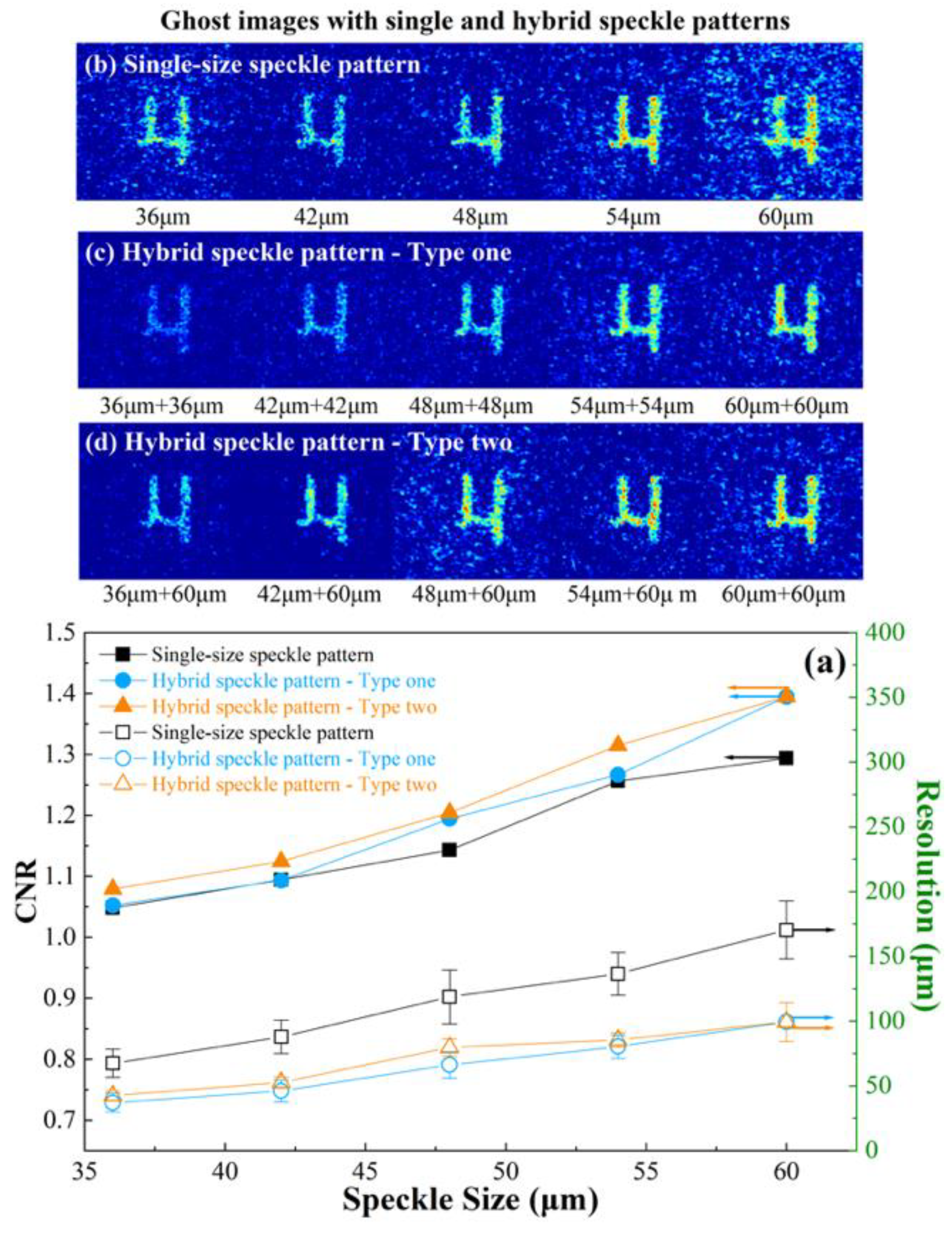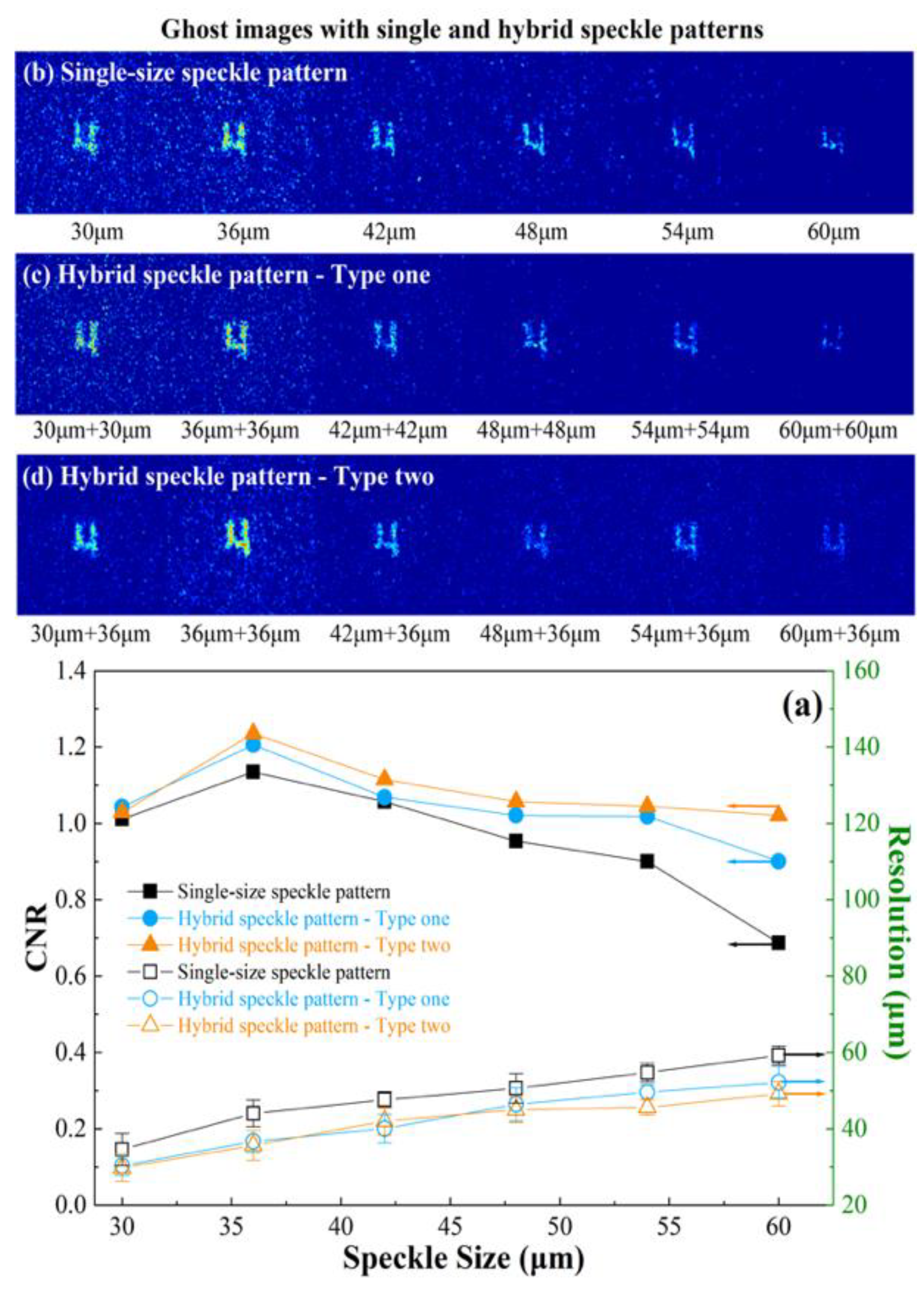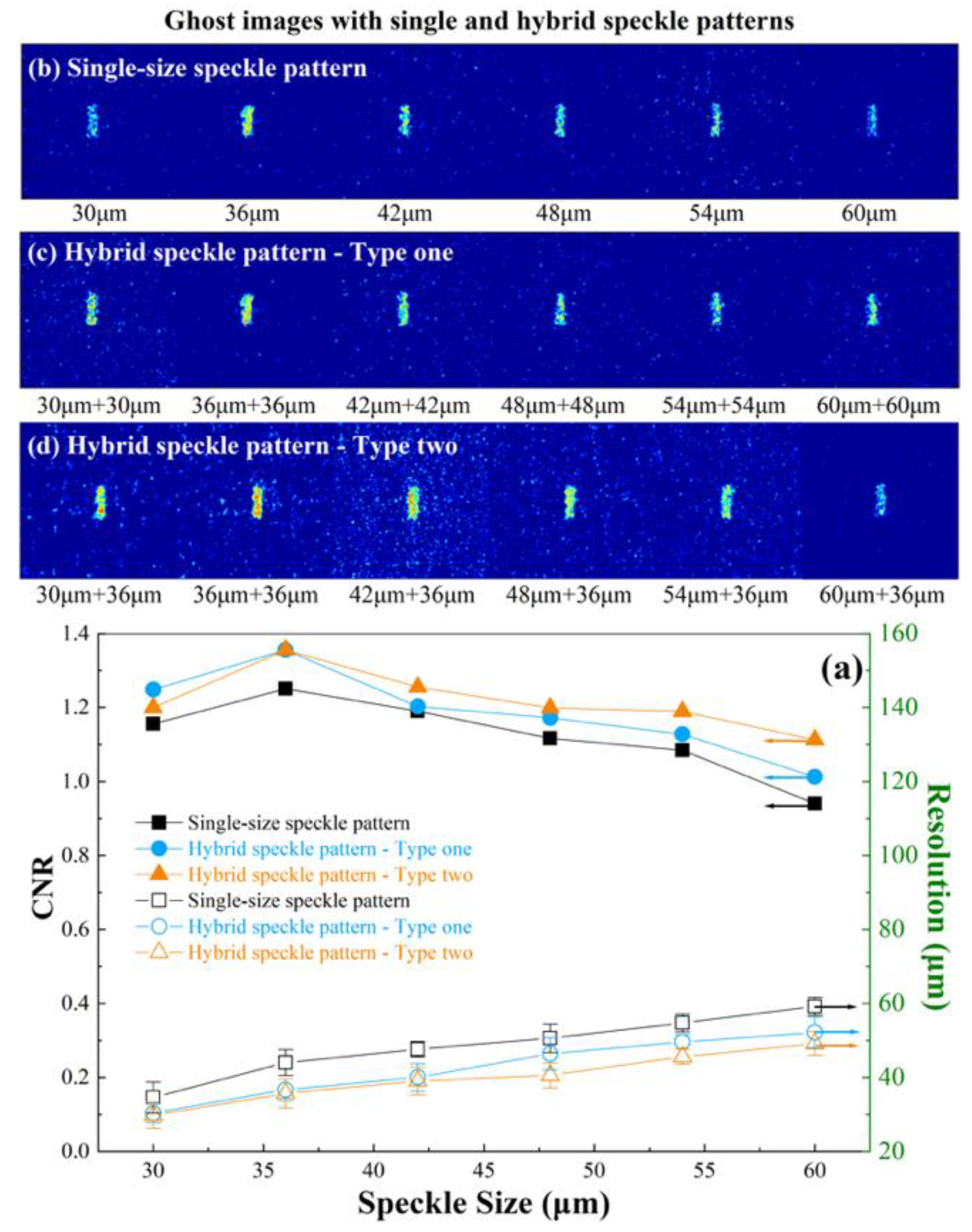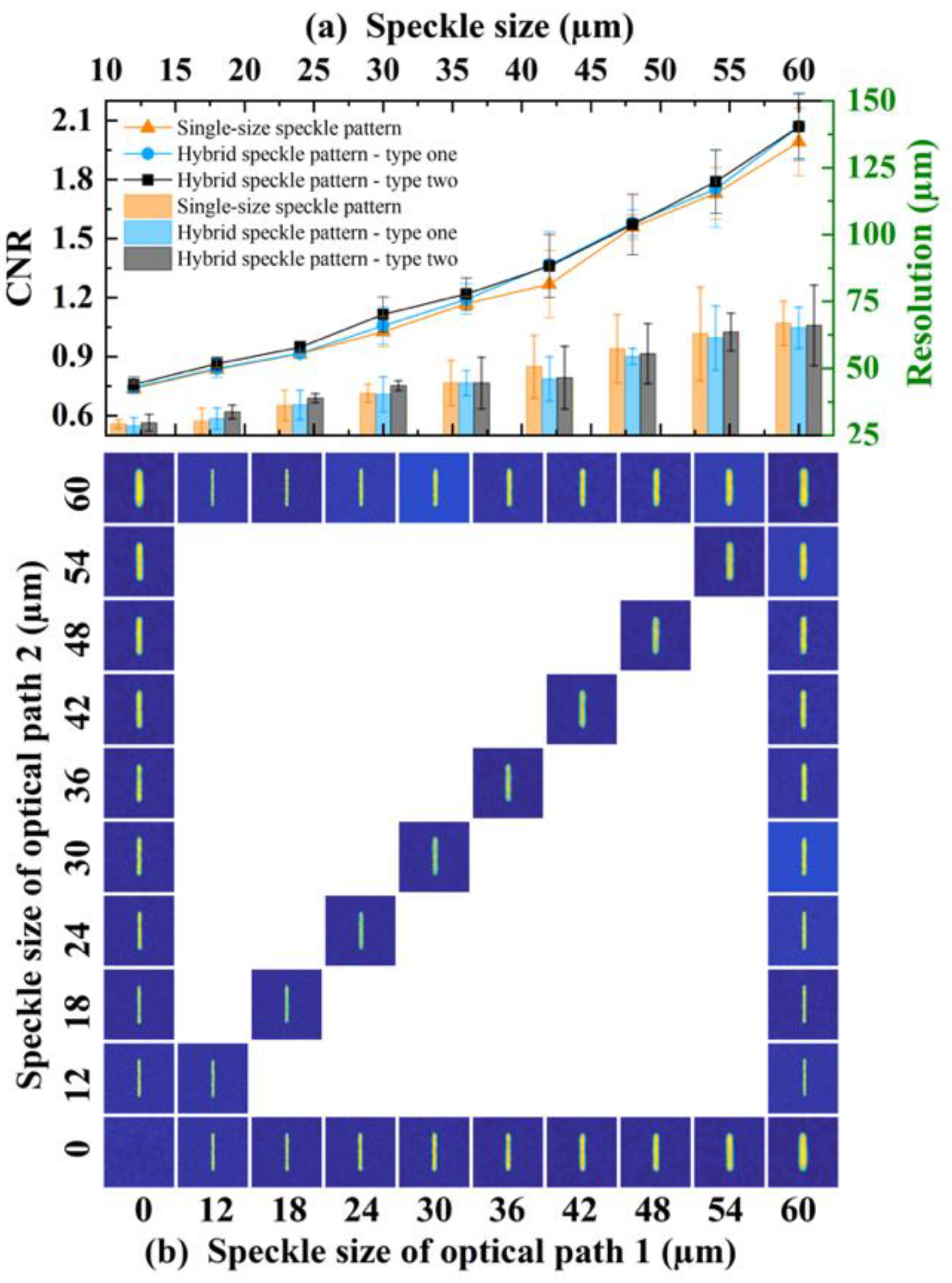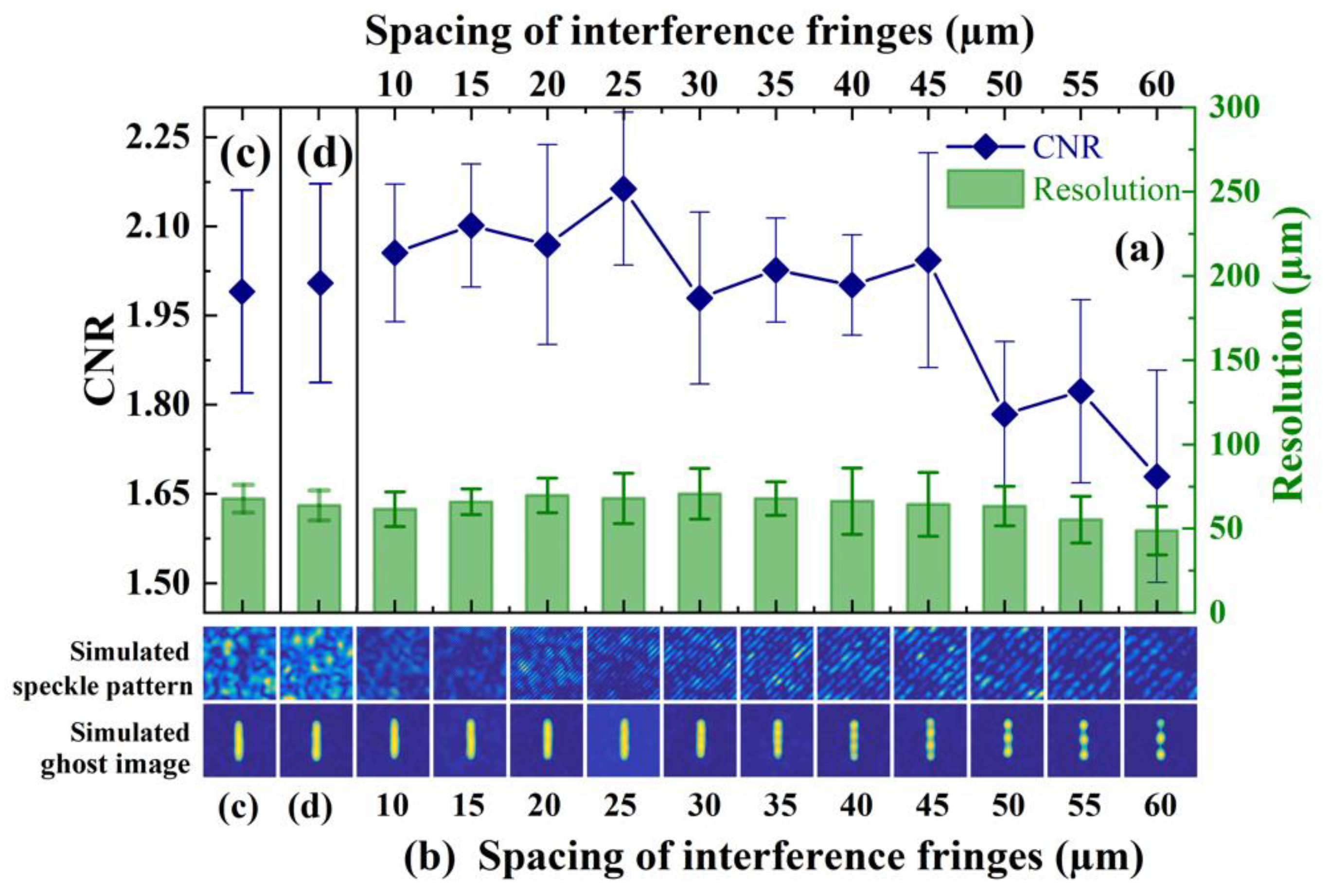3.1. Experimental Results and Discussion
Starting with object 1, the speckle size was increased from 36 µm to 60 µm in five steps, followed by reconstruction with 10,000 iterations under the same conditions. In the traditional single-size speckle pattern imaging condition, the retrieved ghost image CNR-dependent speckle size was found to be in good agreement with [
18,
19,
20,
21,
22,
23], which indicates a growth of the CNR and a reduced resolution proportional to the speckle size in
Figure 2 (black line with solid squares and black line with hollow squares). The highest CNR ghost image was obtained with the largest speckle size of 60 µm. The best resolution was obtained with the smallest speckle size of 36 µm.
To verify the image quality evolution with the hybrid speckle pattern, we designed two types of combinations experiments as presented in
Table 1. For the type-one hybrid speckle pattern, aperture 1 and aperture 2 had the same diameter. In this case, the hybrid speckle patterns were built up by two similar speckle patterns. The speckle size was increased from 36 µm to 60 µm in five steps, so we had five kinds of hybrid speckle patterns for ghost imaging. For the type-two hybrid speckle pattern, aperture 1 and aperture 2 had different diameters. Because the highest CNR can be obtained by using a ~60 μm speckle size in a single-size speckle pattern imaging condition, we fixed the diameter of aperture 2 at 1 mm diameter to obtain a ~60 μm speckle size. The speckles after aperture 1 were stepwise increased from 36 µm to 60 µm.
To clearly understand and generalize the influence of hybrid speckle patterns on the CNR of the retrieved ghost images for an object of a given size, we evaluated the CNR and resolution as a function of the two types of hybrid speckle patterns. For easy comparison between the CNR and resolution resulting from a single-size speckle pattern, we plot the speckle size after aperture 1 with a common abscissa in
Figure 2a. The corresponding marked retrieved ghost images are exhibited in
Figure 2b–d. In
Figure 2 (blue line with solid circles), we summarize the dependence of the CNR on the type-one hybrid speckle pattern. The corresponding resolution is shown in
Figure 2 (blue line with hollow circles). The scaling of the CNR and resolution undergoes the same evolution with the single-size speckle pattern imaging. In most cases, this hybrid speckle superimposed by the same speckle shows a clear advantage in imaging quality. This advantage is further improved when changing to a type-two hybrid speckle pattern. As we can see from
Figure 2 (orange line with solid triangles), the CNR of the retrieved ghost images is slightly higher than the type-one hybrid speckle pattern for ghost imaging because of the larger speckles. At the same time, the resolution is slightly lower than that of the type-one hybrid speckle pattern in
Figure 2 (orange line with hollow triangles).
These observations implied that the large speckles in the hybrid speckle pattern contributed substantially to the improvement of the CNR of the ghost images, and the small speckles were also helpful to the improvement of resolution during the ghost imaging reconstruction. First, we used single-size speckles for ghost imaging and selected the speckle size that achieved the highest CNR as one size of speckle in the hybrid speckle field. Here, the speckles with optimal size always provided the most benefits to the improvement of the CNR in ghost imaging with the hybrid speckle pattern. On one hand, when the two optimized speckles were used in the hybrid speckle pattern, the CNR reached its maximum value. On the other hand, because of the coherence of the light field, the hybrid speckle field produced finer interference fringes in some parts of the hybrid speckle field where the speckles overlapped. These finer stripes provided a significant contribution to the increase in resolution. Thus, the ghost imaging resolution of the hybrid speckle pattern was higher than that of the single-size speckle pattern.
This indicated that an optimal hybrid speckle pattern existed in the PGI, for which the maximum CNR with a better resolution can be achieved for the given object size. In the experiment, we separately compared the two beams with the same speckle size for ghost imaging, and the image quality was almost the same. Subsequently, in the hybrid speckle pattern ghost imaging experiment, we believed that fixing the speckle size of any one of the beams would not affect the experimental results. Moreover, this scaling was easily observed from the ghost images represented by false color, as in
Figure 2b–d. It is worth noting that the retrieved ghost images that are visible to the naked eye are not exactly the same as the image with the highest CNR, because the CNR takes full image noise into account (given by Equation (2)). Therefore, we used both CNR and resolution to estimate the image quality.
By reducing the size of the object to the microscopic scale, the speckle size became comparable to the dimension of the object. The CNR scaling of object 2, with features in the speckle size range, exhibited a different scaling compared to object 1. Here, we used a set of smaller-sized speckle patterns to study the properties of the retrieved ghost images with hybrid speckle patterns. It was observed that the CNR showed an increasing trend from the speckle size of 30 μm. Then, it reached a maximum of 36 µm, following which it dropped continuously, as shown in
Figure 3 (black line with solid squares). The reason for the reversed trend is that the noise level of the photodiode is the major limitation to the growth of the CNR for large speckle sizes. The lower transmission reduces the margin between typical signal levels, and the noisy background of the photodiode results in a shift from the maximum CNR with respect to smaller speckle sizes. With the increase in noise level, this effect becomes increasingly prominent in fields with smaller speckle sizes [
27].
In addition to the CNR, the resolution of the retrieved images was evaluated. Different from the CNR, the resolution is mainly affected by the speckle size, i.e., the resolution increases with smaller speckle sizes independent of the dimension of the object. However, due to the limitation of the pixel size of the camera, the resolution will not increase further. Therefore, in the case of object 2, because of the limited detection capabilities of the system, decreasing the speckle size resulted in a higher CNR and a higher resolution. Moreover, the resolution itself was limited by the pixel size of the imaging device and was comparable to the resolution achieved with shadow grams of object 2. Thus, the declining trend of the resolution of object 2 was slower than that of object 1.
As presented in
Table 2, we also provide two types of combination experiments to verify the image quality evolution of hybrid speckle patterns. Because of the increase in resolution with smaller speckle sizes, which is independent of the dimension of the object, the trade-off must only be considered for object 1. On the contrary, in the case of object 2, because of the limited detection capabilities of the system, decreasing the speckle size resulted in a higher CNR and a higher resolution. In this way, for type-two hybrid speckle pattern, aperture 2 fixed at a 2 mm diameter to obtain a ~36 μm speckle size obtained the highest CNR with a higher resolution in single-size speckle pattern imaging condition. The speckles after aperture 1 increased from 30 µm to 60 µm in six steps. The type-one hybrid speckle pattern remained unchanged. In
Figure 3 (blue line with solid circles and orange line with solid triangles), we summarize the dependence of the CNR on type-one and -two hybrid speckle patterns, and the corresponding resolutions are shown in
Figure 3 (blue line with hollow circles and orange line with hollow triangles). Both CNRs with hybrid speckle patterns decrease rapidly with increasing speckle size after the pattern 2 series because of the negligible bucket detector noise signal. For the type-two hybrid speckle pattern, because it has smaller speckles, it is easier to achieve ghost imaging with a high CNR and resolution in this case.
Comparing the results with the single-size speckle pattern, the following conclusion can be derived: the scaling of the retrieved ghost image CNR and resolution strongly depend on the combination of the hybrid speckle patterns for the same number of independent iterations. The method of using the hybrid speckle pattern instead of the single-size speckle pattern to improve the quality of ghost imaging can be extended from macroscopic to microscopic imaging.
To generalize our observations in PGI, the experiment was repeated with two slits with the same transmission area. For comparison, two slits with the size of 1200 μm × 150 μm and 517 μm × 150 μm, respectively, were used.
Figure 4 and
Figure 5 show the experimental results of the CNRs for test slits 1 and 2, corresponding to objects 1 and 2. The ghost images for the two slits were retrieved by 10,000 independent iterations of the corresponding speckle patterns. The agreement between the estimated CNR and resolution for the two completely differently shaped objects with the same transparent area was excellent. A slight discrepancy was observed because of the deviation of the object area selected for the measurement, and some uncertainties in the estimated area of the “µ” and/or small errors in setting the slit width.
3.2. Simulation Results
To validate the experimentally observed enhanced image quality of hybrid speckle patterns, the interference speckle pattern model was developed to simulate the observed behavior. It can independently vary the interference parameters over a wide range to identify their role in the observed scaling of the CNR for hybrid speckle patterns. First, we implemented an expression to numerically generate random speckle fields based on the interference of two monochromatic waves [
31]. Then, we developed the hybrid speckle pattern model to reconstruct the ghost image.
Figure 6 shows the reconstruction images of the slit with the size of 1200 μm × 150 μm for 25 different combinations of hybrid speckle patterns, ranging from a speckle size of 12 µm to 60 µm. The retrieved ghost images are given by the combination of the speckles, both in abscissa and ordinate. We also present 19 retrieved ghost images with single-size speckle patterns obtained by only one optical path for comparison. The speckle size of 0 μm means the optical path has no contribution to the ghost imaging reconstruction. In this case, we obtained the ghost image with a single-size speckle pattern. Since the two optical paths use the same speckle for ghost imaging, the imaging quality is almost the same as in the experiment. Thus, we considered that the contribution of the two optical paths to ghost imaging must be the same in the simulation. By comparing the simulation results with the experimental results described above, two types of hybrid speckle patterns were identified for a given combination of hybrid speckle patterns. The retrieved ghost image of the type-two hybrid speckle pattern exhibited better features than the type-one hybrid speckle pattern, resulting in a slightly higher CNR. Moreover, the retrieved ghost images of the hybrid speckle pattern had a higher CNR than those of the single-size speckle pattern.
It has been proven by Ref. [
23] that the anomalous evolution law of the speckles and image quality for a smaller object is only caused by the detector noise level. Thus, we only use object 2 for simulation. It is worth noting that we set the spacing of interference fringes of the simulated hybrid speckle pattern close to the experiment. We did not discuss the influence of the spacing of interference fringes for hybrid speckle patterns on image quality in the experiment, but we made the comparison in the simulation.
To further analyze the influence of the hybrid speckle pattern on ghost image quality, we simulated the hybrid speckle pattern with the different spacing of interference fringes in
Figure 7a and corresponding retrieved ghost images in
Figure 7b. The theory of the spacing of interference fringes in the simulation can be explained by Young’s double-slit interference experiment [
31]. Because the best image quality was obtained by pattern V of the type-one hybrid speckle pattern (60 μm + 60 μm) when the spacing of interference fringes was 20 μm in
Figure 6, we chose it for the simulation. We first made a comparison with the single-size speckle pattern with a speckle size of 60 μm. It is clear to see that the quality of the retrieved ghost images with hybrid speckle patterns having 20 μm spacing of interference fringes is better than the single-speckle pattern in
Figure 7a,c. This behavior can be attributed to the interference between the hybrid speckles, which were strongly modified in the speckle fields. We also simulated pattern V of the type-one hybrid speckle pattern without interference fringes. The calculated CNR and resolution of the retrieved ghost images of the hybrid speckle pattern without interference fringes were close to the single-speckle pattern in
Figure 7d. Thus, the hybrid speckle pattern without interference fringes was almost equivalent to a random speckle pattern with a fixed single size.
Then, we studied the evolution of the calculated CNR and resolution of the retrieved ghost images with the spacing of interference fringes of the hybrid speckle pattern. It was observed that the CNR showed a slight increase for a small spacing of interference fringes until it reached a maximum, following a stepwise decrease, as shown in
Figure 7a. Different from the CNR, the resolution did not significantly vary. Thus, the shape of the retrieved ghost images worsened above a 40 μm interference fringe spacing. In
Figure 7b, we show the corresponding speckle patterns for different interference fringe distances. The ghost imaging images obtained using these speckle patterns are also given in
Figure 7b. To make the simulation closer to the experiment, we selected the spacing of interference fringes with 20 μm to simulate the ghost imaging effect of the hybrid speckle pattern. However, it can be seen from the results in
Figure 7b that it was not the best choice for acquiring a better image quality. In the future, we can further optimize our experiments when the spacing of interference fringes of the hybrid speckle pattern is close to 25 μm by adjusting the parameters of the input laser.
The hybrid speckle patterns show advantages in improving the image quality of PGI, but also has a limitation for practical applications due to the necessity of the precise control of the arm lengths in the experimental setup. With the help of the correlation function introduced in Refs. [
32,
33,
34], we can classify the different speckle pattern states by their robustness to deviations from the ideal setup. We simulated the correlation evolution dependent on the error in propagation lengths between the reference and test beam with the hybrid speckle pattern and single-size speckle pattern. As seen in
Figure 8, as the single-speckle size increased, the correlation factor increased. The correlation of the single-size speckle pattern was significantly higher than the hybrid speckle pattern within a large error in the range of propagation lengths. For the type-one hybrid speckle pattern (60 μm + 60 μm), the correlation factor did not drop significantly over a wide range, although it was also slightly lower than the correlation factor for single-speckle sizes larger than 48 μm. On the contrary, for the other hybrid speckle patterns, the correlation factor was lower than the single-speckle size of 18 μm, even close to the correlation factor of the minimum single-speckle size of 12 μm. Especially for the type-two hybrid speckle pattern (12 μm + 60 μm), the correlation appeared to be greatly reduced after the error exceeded a few million meters. This means that for the vast majority of hybrid speckle patterns used in PGI, the length error between the reference and test beams must be precisely controlled.
